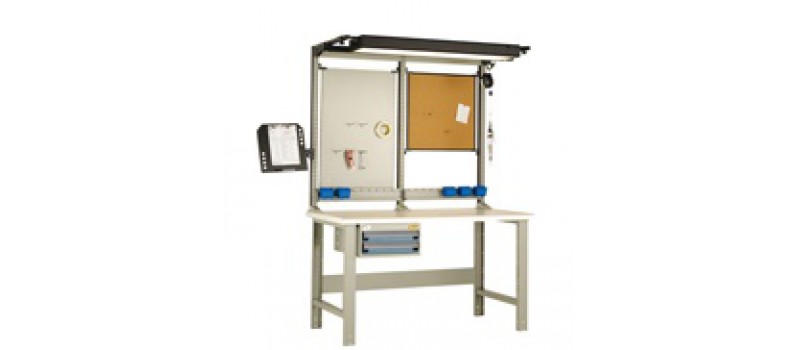Using a workstation in factories can offer several benefits for the workers and the facility's overall productivity. Here are some advantages of using workstations in factories:
- Increased efficiency: Workstations are designed to provide an organized and dedicated space for specific tasks. Having designated workstations allows workers to focus on their assigned tasks without distractions or interruptions, increasing productivity and efficiency.
- Improved ergonomics: Workstations can be ergonomically designed to promote proper posture, reduce strain on the body, and minimize the risk of injuries such as back pain or repetitive strain injuries. Ergonomic workstations can enhance worker comfort, reduce fatigue, and improve overall health and well-being.
- Enhanced organization: Workstations allow better organization of tools, equipment, and materials required for specific tasks. By having everything in one place, workers can easily access the necessary tools, reducing the time spent searching for or gathering materials. This streamlines the workflow and contributes to a more efficient production process.
- Standardization and consistency: Workstations can be designed to have a standardized layout and setup across the factory floor. This consistency ensures that workers across different shifts or teams can quickly adapt to other workstations, resulting in smoother transitions and reduced learning curves when new employees join the workforce.
- Quality control: Workstations can include features or tools that facilitate quality control processes. For example, they can have built-in inspection stations or testing equipment to ensure that products meet the required standards before moving to the next production stage. This helps detect defects or issues early on, reducing the chances of faulty products reaching the market.
- Flexibility and adaptability: Workstations can be designed to accommodate specific tasks or processes and easily reconfigured or modified to adapt to changing production needs. This flexibility allows factories to adjust their workstation layouts or add new workstations as required, enabling efficient utilization of space and resources.
- Safety and hazard mitigation: Workstations can be designed with safety features and considerations in mind. For example, they can incorporate safety guards, emergency stops, or clear signage to minimize the risk of accidents. In addition, by creating designated areas for specific tasks, workstations can help segregate hazardous operations, ensuring that workers are protected and minimizing the likelihood of accidents or injuries.
- Training and skill development: Workstations provide a focused environment for training new employees or upskilling existing workers. With dedicated workstations, trainers can efficiently demonstrate specific tasks or processes, and trainees can practice in a controlled and consistent setting. This contributes to effective skill development and faster onboarding of new workers.
Workstations are crucial in optimizing workflow, ensuring worker safety and well-being, and improving factory productivity. In addition, by providing dedicated spaces for specific tasks and incorporating ergonomic design principles, workstations contribute to a more efficient and effective manufacturing process.

Using a workstation effectively involves several key steps.
Here's a general guide on how to use a workstation in a factory setting:
- Familiarize yourself with the workstation: Take the time to understand the layout, components, and features. This includes understanding the purpose of each tool, equipment, or system integrated into the workstation.
- Organize your workspace: Keep your workstation clean, clutter-free, and well-organized. Arrange tools, materials, and supplies in a logical and accessible manner. This ensures that everything you need is readily available and minimizes the time spent searching for items.
- Follow safety protocols: Familiarize yourself with your workstation's safety guidelines and procedures. Ensure you understand how to operate safety features, such as emergency stops or guards, and adhere to all safety regulations to protect yourself and others.
- Plan your workflow: Determine the tasks you must complete at the workstation. Consider any dependencies or specific instructions related to the production process. Having a clear plan helps you work efficiently and avoid errors or delays.
- Use proper ergonomics: Pay attention to ergonomics to maintain good posture, reduce strain on your body, and prevent injuries. Adjust the workstation's height, chair, and other components to ensure a comfortable and ergonomic position. Take breaks and stretch periodically to avoid prolonged sitting or repetitive motions.
- Execute tasks accurately: Perform your assigned functions according to the established procedures and guidelines. Make use of any specialized equipment or tools integrated into the workstation. Pay attention to details and quality requirements to ensure your work meets the necessary standards.
- Maintain cleanliness: Keep your workstation clean throughout your work shift. Regularly remove waste materials, clean surfaces, and organize any loose items. This promotes a safe and hygienic work environment and contributes to overall efficiency.
- Communicate and collaborate: If your work involves interacting with other team members or departments, maintain effective communication. For example, coordinate with colleagues, supervisors, or operators working in adjacent workstations to ensure a smooth workflow and timely exchange of information.
- Troubleshoot and report issues: If you encounter any problems, malfunctions, or safety concerns related to the workstation or its components, report them promptly to the appropriate personnel. Follow established protocols for troubleshooting or seeking assistance to minimize disruptions and maintain productivity.
- Continuous improvement: Regularly assess your work processes and workstation setup for opportunities to improve efficiency or safety. Provide feedback or suggestions to supervisors or relevant teams regarding any modifications or enhancements that could optimize the workstation's performance.
Remember, the specific steps may vary depending on the nature of the workstation and the tasks performed. Therefore, following the guidelines, procedures, and training your employer or supervisor provides for the specific workstation you are using is essential.
Note: Always follow the manufacturer's instructions and safety guidelines when using this product. Following the manufacturer's guidelines is generally a good idea when using any product or equipment. Still, it's also essential to use your judgment and seek expert advice when necessary. Specifications are subject to change without notice.






































